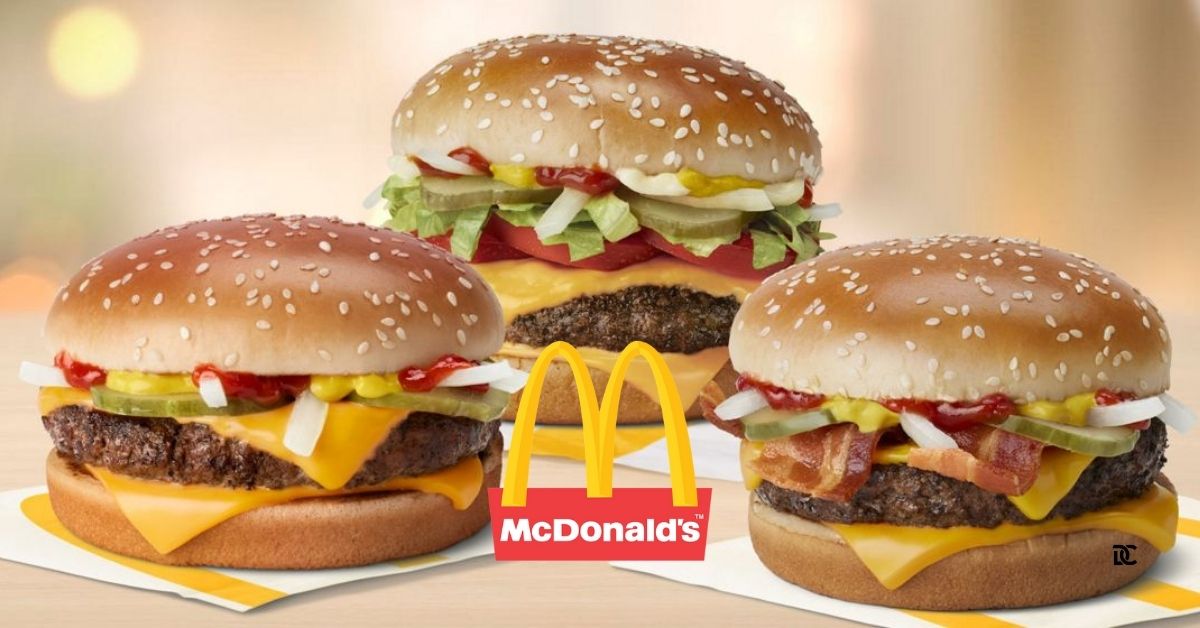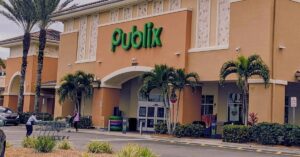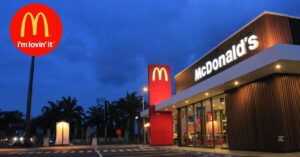A concerning E. coli outbreak has emerged, with McDonald’s Quarter Pounder hamburgers identified as the primary source of contamination. This outbreak has resulted in the death of one individual and left 49 others ill across ten states, according to a recent report from the Centers for Disease Control and Prevention (CDC). The implicated slivered onions used in the Quarter Pounders are under intense scrutiny as the suspected source of bacterial contamination.
E. coli, or Escherichia coli, is a type of bacteria commonly found in the intestines of humans and animals. While most strains of E. coli are harmless and play a crucial role in maintaining gut health, certain strains, such as E. coli O157, can lead to severe foodborne illnesses. These infections can cause a range of symptoms, from mild gastrointestinal discomfort to life-threatening complications like hemolytic uremic syndrome (HUS), which affects the kidneys.
The current outbreak, attributed to the E. coli O157 strain, has affected individuals across ten states, including Colorado, Iowa, Kansas, Missouri, Montana, Nebraska, Oregon, Utah, Wisconsin, and Wyoming. The CDC reports that the infections occurred between September 27 and October 11, with Colorado being the hardest hit, accounting for 27 of the reported cases. Nebraska follows with nine cases, while the remaining states have recorded fewer incidents.
The outbreak has had a significant impact on public health and the operations of McDonald’s. As of the latest update, one older individual in Colorado has tragically lost their life due to the infection. Additionally, ten people have been hospitalized, including a child who is battling severe kidney complications. The CDC warns that the actual number of affected individuals may be higher as many recover without seeking medical attention.
Also Read
Symptoms of E. Coli Infection
Understanding the symptoms of an E. coli infection is crucial for early detection and treatment. Common symptoms include:
- Severe Stomach Cramps: Intense abdominal pain is often one of the first signs of an E. coli infection.
- Bloody Diarrhea: This is a hallmark symptom, indicating the body’s response to the bacterial invasion.
- Vomiting: Persistent vomiting can lead to dehydration, exacerbating the severity of the illness.
- Fever: While not always present, a mild fever may accompany the infection.
In severe cases, E. coli infections can lead to hemolytic uremic syndrome (HUS), a condition that affects the kidneys and can be life-threatening, especially in vulnerable populations like children and the elderly.
CDC and FDA Investigations
The CDC, in collaboration with the Food and Drug Administration (FDA), has launched a thorough investigation to identify the precise source of the E. coli contamination. Initial findings point to the slivered onions used in McDonald’s Quarter Pounders as the likely source. These onions are sourced from a single supplier that serves three distribution centers, suggesting a widespread contamination event.
The investigation is ongoing, with health officials also examining whether the hamburger patties themselves could be contributing to the outbreak. This comprehensive approach aims to ensure that all potential sources of contamination are identified and addressed to prevent further infections.
McDonald’s Response to the Outbreak
In light of the outbreak, McDonald’s has taken swift and decisive action to safeguard its customers and maintain trust in its brand. The company’s response has been multifaceted, focusing on the immediate suspension of affected products and collaboration with health authorities to resolve the issue.
Suspension of Quarter Pounders
McDonald’s has suspended the sales of Quarter Pounder hamburgers in twelve states, including the most affected: Colorado, Nebraska, Kansas, and Utah. This suspension is a precautionary measure to prevent further spread of the bacteria and to allow for a thorough investigation of the contamination source.
Removal of Contaminated Onions
The fast-food giant has ceased the use of the implicated slivered onions in its Quarter Pounders. By removing this ingredient, McDonald’s aims to eliminate the primary source of E. coli contamination. The company is also investigating the possibility that the hamburger patties may be a contributing factor, ensuring that all potential sources are addressed.
Ensuring Food Safety
McDonald’s has reiterated its commitment to food safety, emphasizing that customer well-being is its top priority. Cesar Piña, McDonald’s North America Chief Supply Chain Officer, stated:
“Across the McDonald’s System, serving customers safely in every single restaurant, each and every day, is our top priority and something we’ll never compromise on. It is why we are taking swift and decisive action following an E. coli outbreak in certain states.”
In addition to removing the contaminated onions, McDonald’s has paused the distribution of all slivered onions in the impacted areas. The company is working closely with its suppliers to replenish the supply of safe ingredients and restore normal operations as quickly as possible.
Despite the suspension of Quarter Pounders in affected areas, McDonald’s has assured customers that other menu items remain safe and available. Products such as Cheeseburger, Hamburger, Big Mac, McDouble, and Double Cheeseburger are unaffected by the outbreak and continue to be served across all locations. This move aims to minimize disruption for customers while addressing the specific issue related to the Quarter Pounders.
McDonald’s Commitment to Transparency
McDonald’s has been proactive in communicating with both the public and its franchisees. The company has issued a stock recovery notice to impacted restaurants, providing clear instructions on removing the contaminated onions and suspending the sale of Quarter Pounders. McDonald’s encourages restaurants to reach out to their field supply chain managers or distribution centers with any questions, ensuring that franchisees have the support they need during this crisis.
Furthermore, McDonald’s is committed to providing timely updates as the situation evolves. The company is working closely with the CDC and other health authorities to monitor the outbreak and implement necessary measures to prevent further contamination.
What is The McDonald’s Quarter Pounder?

The Quarter Pounder is one of McDonald’s flagship products, known for its hearty beef patty and signature slivered onions. Introduced in 1971 by Al Bernardin, a franchise owner and former McDonald’s Vice President of Product Development, the Quarter Pounder was designed to offer customers a more substantial burger option compared to the traditional Hamburger.
Originally named for its quarter-pound beef patty, the Quarter Pounder has undergone several changes over the years. In 2013, McDonald’s expanded the Quarter Pounder line to include a variety of hamburgers, replacing the discontinued Angus hamburger. This expansion was partly due to the high cost of Angus beef, which led McDonald’s to focus on maintaining affordability while offering quality.
In 2015, McDonald’s increased the pre-cooked weight of the Quarter Pounder patty to 4.25 ounces (120 grams), enhancing its appeal to customers seeking a more filling meal. The Quarter Pounder’s combination of a substantial beef patty, fresh slivered onions, and other classic toppings has made it a popular choice among McDonald’s patrons worldwide.
What You Need to Know About E. Coli
E. coli infections are a significant public health concern, particularly when linked to widely consumed food products. Understanding the sources and prevention methods is crucial for both consumers and food service providers.

Sources of E. Coli Contamination
E. coli bacteria can contaminate food through various pathways, including:
- Contaminated Ingredients: Raw or undercooked meat, unpasteurized dairy products, and contaminated vegetables can harbor E. coli bacteria.
- Poor Hygiene Practices: Inadequate handwashing, improper handling of food, and unsanitary kitchen environments can facilitate the spread of E. coli.
- Cross-Contamination: Using the same surfaces or utensils for raw and cooked foods without proper cleaning can transfer bacteria.
In the case of the current outbreak, the slivered onions used in McDonald’s Quarter Pounders are identified as the likely source of E. coli contamination. This points to a lapse in the supply chain’s safety protocols, necessitating immediate corrective actions.
Preventing E. Coli Infections
Preventing E. coli infections requires a combination of proper food handling, cooking, and hygiene practices. Key preventive measures include:
- Cooking Meat Thoroughly: Ensuring that ground beef is cooked to an internal temperature of at least 160°F (71°C) to kill harmful bacteria.
- Washing Fruits and Vegetables: Thoroughly rinse produce under running water to remove potential contaminants.
- Avoiding Cross-Contamination: Using separate cutting boards and utensils for raw and cooked foods.
- Maintaining Cleanliness: Regularly cleaning kitchen surfaces, utensils, and hands to prevent the spread of bacteria.
For consumers, being aware of these practices can significantly reduce the risk of E. coli infections. For food service providers like McDonald’s, strict adherence to food safety protocols is essential to protect public health and maintain customer trust.
Public Response
The CDC and FDA have been at the forefront of the response to the E. coli outbreak linked to McDonald’s Quarter Pounders. Their collaborative efforts aim to identify the contamination source, track the spread of the infection, and implement measures to prevent further cases.
Tracking the Outbreak
Epidemiologists and public health officials are employing various methods to track the outbreak, including:
- Case Reporting: Collecting data from hospitals and clinics to identify and monitor affected individuals.
- Environmental Testing: Sampling food products, surfaces, and environments in McDonald’s restaurants to detect the presence of E. coli bacteria.
- Supply Chain Analysis: Investigating the supply chain of the implicated slivered onions to identify potential contamination points.
Public Communication
Effective communication is critical during such outbreaks to inform the public and guide their actions. The CDC has been providing regular updates on the situation, outlining the symptoms of E. coli infection, advising on when to seek medical help, and offering guidance on preventive measures.
McDonald’s has also played a role in public communication by issuing statements, notifying affected restaurants, and working with health authorities to manage the outbreak. Transparency and timely information dissemination are essential to maintaining public trust and ensuring that individuals take appropriate actions to protect their health.
Legal and Economic Implications
Foodborne illness outbreaks can have significant legal and economic repercussions for the implicated companies. McDonald’s, as a global fast-food leader, faces potential lawsuits, financial losses, and damage to its brand reputation due to the E. coli outbreak.
Potential Legal Actions
Individuals affected by the outbreak may seek legal recourse against McDonald’s for negligence in ensuring food safety. Lawsuits could allege that McDonald’s failed to maintain adequate hygiene standards, leading to the contamination of their Quarter Pounders. If found liable, McDonald’s could face substantial financial penalties, including compensation for medical expenses, lost wages, and pain and suffering of the victims.
Impact on McDonald’s
The immediate suspension of Quarter Pounder sales in twelve states can lead to significant revenue losses for McDonald’s. Additionally, the broader impact on customer trust and brand reputation can result in long-term financial consequences. Customers may choose to avoid McDonald’s products out of fear of contamination, leading to decreased sales across the board.
Moreover, the company may incur additional costs related to the investigation, supply chain adjustments, and enhanced food safety measures to prevent future outbreaks. These financial strains can affect McDonald’s profitability and market position, especially if similar incidents recur.
Insurance and Liability
McDonald’s likely has insurance policies in place to cover liabilities arising from such incidents. However, the extent of coverage and the claims process can influence the company’s financial stability during this crisis. Insurance payouts can help mitigate some of the economic impacts, but they may not fully compensate for the long-term damage to the brand.
Impact on Suppliers and Supply Chain
The identification of slivered onions from a single supplier as the likely source of contamination has broader implications for McDonald’s supply chain management and its relationships with suppliers.
Ensuring the safety and quality of ingredients is paramount for food service providers. The outbreak highlights the critical role suppliers play in maintaining food safety standards. McDonald’s must work closely with its suppliers to ensure that all products meet stringent safety criteria. In cases of contamination, suppliers may face penalties, contract terminations, or increased scrutiny to prevent future incidents.
The outbreak underscores the importance of supply chain transparency and traceability. Being able to quickly identify and isolate the source of contamination is crucial for effective outbreak management. McDonald’s may need to implement more robust tracking systems and collaborate with suppliers to enhance traceability, ensuring that any future issues can be swiftly addressed.
In response to the outbreak, McDonald’s may review and strengthen its safety protocols across the supply chain. This could involve more frequent testing of ingredients, stricter hygiene standards, and enhanced training for suppliers on food safety practices. Strengthening these protocols is essential to prevent future outbreaks and maintain customer trust.
Consumer Trust and Brand Reputation
Maintaining consumer trust is vital for McDonald’s, especially in the wake of a public health crisis. The company’s handling of the E. coli outbreak will significantly influence its reputation and customer loyalty.
Transparency and Accountability
Being transparent about the outbreak and taking accountability is key to preserving trust. McDonald’s proactive measures, such as suspending Quarter Pounder sales, removing contaminated ingredients, and collaborating with health authorities, demonstrate a commitment to customer safety. Clear and honest communication about the steps being taken to resolve the issue is essential to reassure customers.
Rebuilding Trust
After such an outbreak, rebuilding trust requires consistent efforts. McDonald’s must ensure that all safety measures are effectively implemented and that similar incidents do not recur. Engaging with customers, addressing their concerns, and demonstrating a genuine commitment to food safety can help restore confidence in the brand.
Long-Term Brand Impact
The long-term impact on McDonald’s brand will depend on how effectively the company manages the outbreak and prevents future incidents. While the immediate economic and reputational damage may be significant, swift and decisive action, coupled with a focus on transparency and customer safety, can mitigate long-term effects.
Public Health Recommendations
In light of the E. coli outbreak, public health officials have issued several recommendations to help individuals protect themselves and their families from infection.
Proper Food Handling at Home
Even though the outbreak is linked to a specific restaurant chain, practicing proper food handling at home is crucial to prevent E. coli infections:
- Cook Meat Thoroughly: Ensure that ground beef is cooked to an internal temperature of at least 160°F (71°C) to kill harmful bacteria.
- Wash Fruits and Vegetables: Rinse produce thoroughly under running water to remove potential contaminants.
- Avoid Cross-Contamination: Use separate cutting boards and utensils for raw and cooked foods, and clean surfaces regularly.
Safe Dining Practices
When dining out, individuals can take the following precautions to reduce the risk of E. coli infection:
- Check Restaurant Hygiene: Choose establishments that maintain high standards of cleanliness and hygiene.
- Inquire About Food Sources: Ask about the sourcing of ingredients and the restaurant’s food safety practices.
- Monitor Food Temperature: Ensure that meat dishes are served at appropriate temperatures to prevent bacterial growth.
Awareness of Symptoms
Being aware of the symptoms of E. coli infection can lead to early detection and treatment:
- Severe Stomach Cramps
- Bloody Diarrhea
- Vomiting
- Fever
If any of these symptoms are present, especially after consuming undercooked or contaminated food, seeking medical attention promptly is essential.
The E. coli outbreak linked to McDonald’s Quarter Pounders serves as a stark reminder of the critical importance of food safety in the fast-food industry. With one fatality and numerous illnesses reported across multiple states, the incident has prompted swift action from both McDonald’s and public health authorities to address the contamination and prevent further cases.
McDonald’s commitment to removing the contaminated onions, suspending Quarter Pounder sales in affected areas, and collaborating with health authorities underscores the company’s dedication to customer safety. However, the outbreak also highlights the need for continuous vigilance, robust supply chain management, and proactive food safety measures to prevent similar incidents in the future.
For consumers, the outbreak reinforces the importance of being aware of food safety practices, recognizing the symptoms of E. coli infection, and taking prompt action if symptoms arise. By staying informed and vigilant, individuals can protect themselves and contribute to broader public health efforts to ensure safe and healthy food consumption.
As the situation evolves, McDonald’s and health authorities remain focused on resolving the outbreak, restoring normal operations, and upholding the highest standards of food safety. The lessons learned from this incident will be instrumental in shaping future practices, ensuring that customer safety remains the paramount priority in the fast-food industry.
For ongoing updates and detailed information about the E. coli outbreak, consumers are encouraged to visit the [CDC’s official website](https://www.cdc.gov/e coli/outbreaks/mcdonalds-quarter-pounder) and follow guidelines to stay safe and informed.






